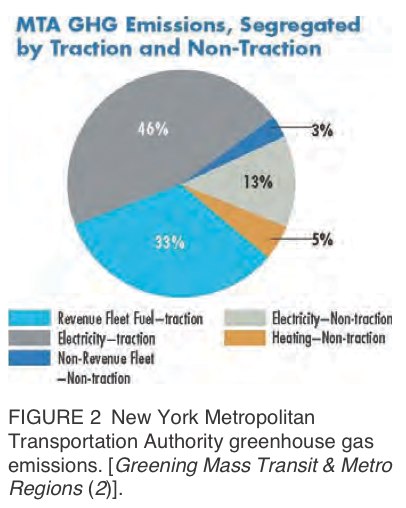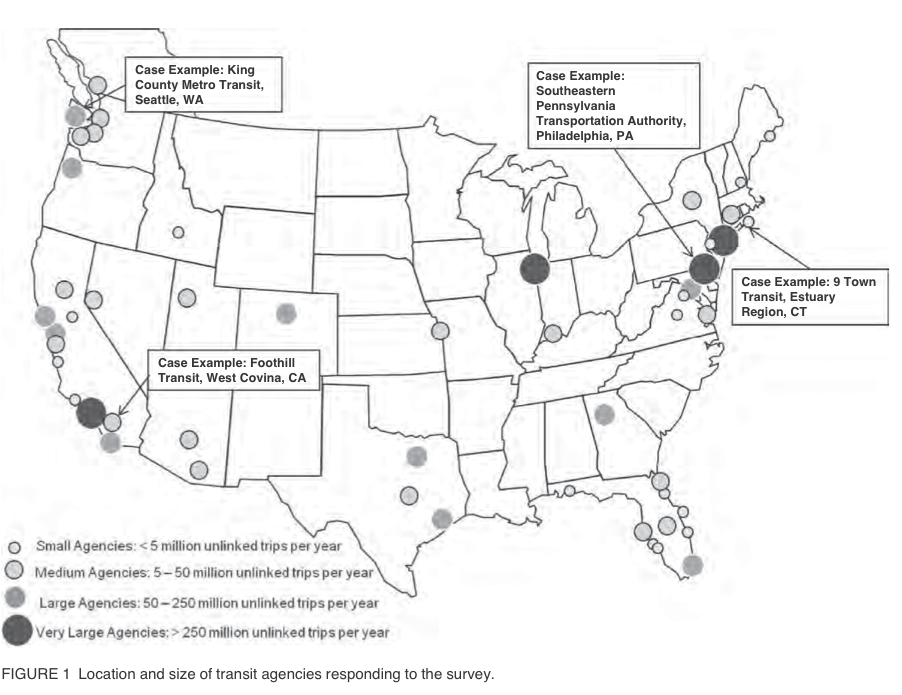TRANSIT COOPERATIVE RESEARCH PROGRAM
Introduction
Synthesis Purpose
Rising energy prices, budget constraints, and concerns about energy independence, sustainability, and climate change have put pressure on all sectors of the economy to use energy as efficiently as possible. This is particularly true in the transportation sector, which accounts for approximately 28% of U.S. energy consumption (1). Frequent, unpredictable fluctuations in gasoline prices have compelled individuals, businesses, and transportation agencies to conserve fuel in order to both save money in the short term and stabilize costs in the long term.
Individuals often seek to save money on fuel and reduce environmental impacts by taking transit instead of driving. It takes significant amounts of energy to construct, operate, and maintain transit systems; therefore, the degree to which this shift yields a net reduction in energy use and fuel costs depends on how efficient transit systems are. From a transit agency’s perspective, using energy more efficiently not only lowers costs, but also enhances service and draws more users, increasing overall system efficiency as well as improving public perception.
 This synthesis provides information for transit agencies on the role that energy plays in all aspects of transit service, the strategies that are available to reduce energy consumption, the potential magnitude of those reductions, and how to strategically plan and implement energy-saving measures. Although some transit agencies may have sustainability or greenhouse gas (GHG) reduction goals that explicitly call for reducing energy use, other agencies may be interested solely in spending less on fueling vehicles and on operating maintenance facilities, transit stations, and office buildings. This latter set of concerns is ever more important as agency budgets become more constrained and transit agencies strive to avoid service cuts or fare increases.
This synthesis provides information for transit agencies on the role that energy plays in all aspects of transit service, the strategies that are available to reduce energy consumption, the potential magnitude of those reductions, and how to strategically plan and implement energy-saving measures. Although some transit agencies may have sustainability or greenhouse gas (GHG) reduction goals that explicitly call for reducing energy use, other agencies may be interested solely in spending less on fueling vehicles and on operating maintenance facilities, transit stations, and office buildings. This latter set of concerns is ever more important as agency budgets become more constrained and transit agencies strive to avoid service cuts or fare increases.
This report draws on existing research and transit agency experience to provide a comprehensive look at energy-saving strategies related to vehicle propulsion, system maintenance, powering stations or stops, and administrative vehicles and buildings. Some of these strategies are specific to transit agencies, whereas others, particularly those related to administrative vehicles and buildings, draw on more general best practices in green building and energy efficiency.
Study Methodology
This synthesis is based on a literature review, a survey of transit agencies, and four follow-up interviews with selected agencies, which were used to develop case examples. The literature review covered a broad range of publication types and sources, including national-level reports from TRB, APTA, and FTA, as well as academic papers, Department of Energy analyses of particular technologies, awards from recent federal grant programs, and transit agency reports on sustainability and energy use.
The survey for this report was conducted in January and February 2012 and was distributed to 74 transit agencies across the United States, as well as to one Canadian agency. It was administered online and distributed by e-mail. Prior to distribution, members of the TCRP synthesis panel tested the survey and it was updated to reflect their comments. Appendix A contains the full text of the survey. Survey recipients were selected based on panel member suggestions and on the consultant’s knowledge of transit agencies that are active in this field. The transit agencies that responded varied widely in terms of agency size, geographic location, and type of transit services that they provided.
The survey was sent to one contact at each agency. Contacts generally represented environmental departments, departments of operations and maintenance, or agency management. Recipients were asked to supply the appropriate agency contact if they were not the correct individual to complete the survey. Agencies that did not initially respond received a follow-up e-mail and a follow-up phone call. In total, 51 agencies responded to the survey, a 69% response rate. Some agencies submitted responses that had been completed with input from multiple individuals or departments, whereas others submitted responses from a single person.
It should be noted that the survey likely overrepresents agencies with active energy-savings programs, because these agencies were targeted as survey recipients. Also, agencies with energy-savings programs were probably more inclined to complete the survey than agencies with little activity to report. Nevertheless, the survey and the large number of responses present an overall picture of the emerging energy-saving technologies and strategies used in the transit industry. Appendix B contains a complete list of survey respondents. Figure 1 shows the location and size of the agencies that responded to the survey.
Read full report (PDF) here: Energy Savings Strategies For Transit Agencies
About the Transit Cooperative Research Program
www.tcrponline.org
“The Transit Cooperative Research Program is your ticket to information central. Whether you are a service provider, consultant or supplier, TCRP provides the tools you need to innovate and solve problems in the transportation industry. The information you need is easily accessible through print, CDs, and online. And best of all — it’s free through APTA!”
Tags: Energy Savings Strategies For Transit Agencies, Green, TCRP, Transit Cooperative Research Program







 RSS Feed
RSS Feed